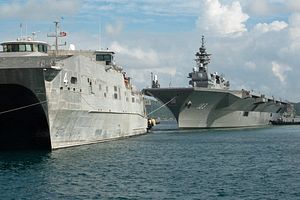This week, Vietnam’s defense minister embarked on a trip to Japan in just the latest in a flurry of foreign forays by the country’s top officials to major power capitals. The visit saw both sides further deepen a defense relationship that has significance not only bilaterally but regionally as well amid the growing chatter around a wider Indo-Pacific vision (See: “Trump’s Indo-Pacific Strategy Challenge”).
As I have noted before in these pages, Japan and Vietnam have been boosting their defense ties as part of their broader extensive strategic partnership over the past few years. Vietnam sees Japan as one important player to engage as part of its wider omnidirectional foreign policy, while Japan sees Vietnam as a key node in its greater engagement of Southeast Asia and as part of its own Indo-Pacific strategy, which, though it has gained traction under U.S. President Donald Trump, dates back over a decade to Japanese Prime Minister Shinzo Abe’s first stint as prime minister from 2006 to 2007 (See: Southeast Asia’s Role in Japan’s Indo-Pacific Strategy”).
The past few years have seen some notable developments in Japan-Vietnam defense relations in particular, including not just ones that make the headlines such as maritime security assistance, but new naval drills, Japanese port calls, an agreement on coast guard cooperation, and discussions on more defense equipment and defense industrial collaboration. Some of these items were discussed between Vietnamese Defense Minister Ngo Xuan Lich and Japanese Defense Minister Itsunori Onodera amid a flurry of meetings on the sidelines of the ASEAN defense meetings in Manila (See: “What Did the ASEAN Defense Meetings in the Philippines Achieve?”).
Developments were expected into 2018 as well, with both sides commemorating the 45th anniversary of the establishment of their diplomatic relationship. And as yet another example of this, from April 7 to 11, Lich paid an official visit to Japan in another notable bilateral defense interaction. Lich’s trip came amid a series of activities Vietnam has had with major regional powers, including President Tran Dai Quang’s trip to India, a historic U.S. aircraft carrier visit to Vietnam, and Lich’s own recent visit to Russia, which attracted fewer headlines but was nonetheless significant within the hierarchy of Vietnam’s partnerships and the balance it seeks in its foreign policy (See: “Why a First US Aircraft Carrier Vietnam Visit Matters”).
During his visit, Lich had a series of engagements and met with a wider range of officials and individuals, including his Japanese counterpart Onodera and Japanese Prime Minister Shinzo Abe. Symbolically, the extent and breadth of the interactions was yet another demonstration of the importance Tokyo places on its relationship with Hanoi and the current trajectory of the relationship, even though it is still moving slower than the rhetoric might suggest.
Substantively, though other cooperation agreements were signed in other areas too, as expected, the key item that came out of the interactions on the defense side was a new Joint Vision Statement inked by the two defense ministers for that realm of the relationship out to the next decade. Few specifics were publicly unveiled about the content of the document, though such statements are reviewed periodically and set out general areas of cooperation to be advanced. Both sides also reportedly discussed furthering cooperation across a range of other areas. The list was quite familiar and included areas of current cooperation such as search and rescue, peacekeeping, humanitarian assistance and disaster relief, maritime security, and cyber security.
Lich and Onodera also discussed regional issues, including the South China Sea, where Vietnam, along with the other three Southeast Asian claimant states, continues to be concerned about China’s maritime assertiveness (See: “Will a China-ASEAN South China Sea Code of Conduct Really Matter?”). References were also made to multilateral engagements, from Japan’s Vientiane Vision that seeks to engage Southeast Asia as a collective region on defense issues to Vietnam’s holding of the annually rotating ASEAN chairmanship that will take place in 2020.
Unsurprisingly, the visit saw references made to the bilateral relationship within Japan’s notion of a Free and Open Indo Pacific as well. With the Trump administration’s focus on the Free and Open Indo-Pacific Strategy within its broader Asia policy along with advances on other initiatives such Asia’s Quad (which groups the United States, Japan, Australia, and India), the concept has been gaining traction even though it remains poorly understood. And as that conversation has been going on, Japan has been continuing to promote its own vision for a Free and Open Indo Pacific, while Vietnam has also shown some receptivity to the idea as well.
Lich’s visit was yet another indication that the concept continues to be a topic of conversation among key regional states. And as Japan and Vietnam continue to engage at various levels through 2018 in the midst of their anniversary, it is yet another angle to keep an eye on within their wider relationship and the broader range of strategic alignments at play in the Indo-Pacific.
































